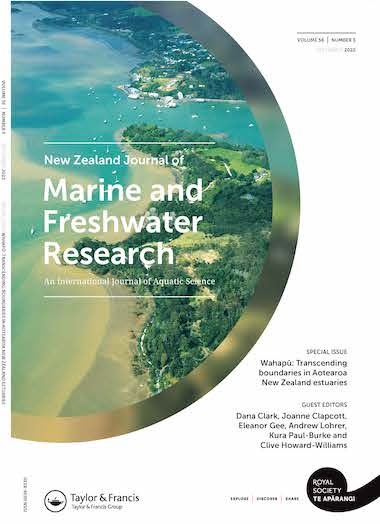News
Published 7 September 2022Special issue on Wahapū: Transcending boundaries in Aotearoa New Zealand estuaries released
A special issue on estuaries has been published in the New Zealand Journal of Marine and Freshwater Research to coincide with the joint New Zealand Marine Science Society and New Zealand Freshwater Sciences Society’s conference, which will be held in Auckland in November 2022

Turbid water above shallow muddy seabed in Mangonui Estuary, Northland, as viewed from above. The energy from waves penetrates to the bed in shallow areas, resuspending fine sediments along the shoreline as the tide rises and falls. Image: Drew Lohrer (NIWA)
As stated in the Editorial:
Estuaries are unique ecosystems where fresh and salt waters mix, connecting land to the ocean. They can take many forms and are known by many names, including wahapū, harbours, lagoons, fjords, bays and sounds. Estuaries provide homes and nursery areas for a diversity of flora and fauna and offer feeding and resting places for migratory species. By filtering, trapping and binding nutrients, sediments and pollutants, estuaries help to keep our coastal waters clear. As transition zones, they are also hotspots of energy transformation and nutrient recycling that sustain broader coastal areas.
In addition to their ecological importance, estuaries are places of significance for the people of Aotearoa New Zealand (hereafter ‘Aotearoa’), delivering substantial economic and cultural value. For Indigenous Māori, estuaries are important mahinga kai (food harvesting areas), cementing cultural responsibilities, history, customs and intergenerational knowledge transmission. Many of our towns and cities are located near estuaries because they provided a safe harbour for local trade and a reliable food source in the early days of settlement. Today, estuaries still function as important trade centres and are valued for the recreational opportunities they provide.
Unfortunately, many estuaries are under cumulative stress from multiple sources. Often these stressors originate externally, including inputs from the land via fresh and storm water (e.g. sediments, nutrients, heavy metals, microplastics, organic pollutants), climate-related drivers and non-indigenous species. Stressors also occur within estuaries themselves, such as shoreline hardening, reclamation, harvesting and dredging for navigation. In recent times, many stressors have been intensified by human activities. The connectivity of estuaries with people and stressors originating beyond the estuary margins necessitates integrated management approaches that transcend boundaries between ecosystem domains, disciplines and knowledge systems. However, these boundaries are rarely traversed, putting estuaries at risk of further degradation.
This Special Issue seeks to highlight research or viewpoints that will help Aotearoa transition towards an integrated approach to estuary management. Here, we contend that the fragmented management of our estuaries stems from a dominant worldview that compartmentalises ecosystem domains, research disciplines and knowledge systems. We discuss how this has led to the development of separate, disjointed policies that fail to protect these valuable environments and highlight how climate change will influence estuary management in the future. Throughout this piece, we provide examples of research and initiatives from this issue (and beyond) that address these issues and help to re-position estuaries at the centre of decision-making.
This Special Issue is being published to coincide with the joint New Zealand Marine Science Society and New Zealand Freshwater Sciences Society’s conference, which will be held in Auckland from 21-24 November 2022 (https://www.waitiwaita.co.nz/). The guest editorial team is planning a special session on integrated estuary management at the conference to showcase the amazing work published in this special issue. All articles in this special issue will be freely available until the end of October.
GUEST EDITORS
Dana Clark (Cawthron), Joanne Clapcott (Cawthron), Eleanor Gee (Waikato Regional Council), Andrew Lohrer (NIWA), Kura Paul-Burke (Waikato) & Clive Howard-Williams (NIWA)
Table of contents
